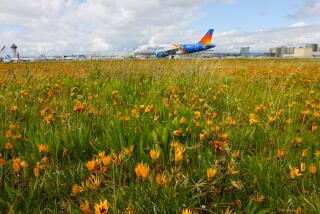Airports Take Aim at Bird Menace
- Share via
NEW YORK — As the morning sky lightens, two federal marksmen raise their shotguns and take aim. A cloud of laughing gulls has risen from Joco Marsh and is heading across a jet runway.
It’s going to be another killing day at Kennedy International Airport.
By sunset, the tarmac will be littered with the carcasses of hundreds of gulls, shot before flying into the paths of oncoming jets.
On food-gathering missions for their young, the birds at Kennedy are a menace to airline safety. Most major U.S. airports have elaborate bird-control programs to reduce midair collisions between birds and planes. Humane, non-lethal approaches are routinely tried first, but are not always effective.
“We hate to kill the birds, but we have no choice,” says Kennedy safety chief Jack K. Gartner, who has received letters from schoolchildren addressed, “Dear Slaughterer.”
Before the controversial shooting started last year, the colony of 20,000 laughing gulls inhabiting a wildlife refuge at the end of a Kennedy runway was responsible for as many as 170 bird-plane collisions a year. In 1991, the number dropped to 60.
Bird-protection organizations insist that this result is not worth the bloodshed. About 15,000 gulls were shot at Kennedy last year.
Although the gull problem at New York’s coastal airport is one of the worst, more than 2,000 collisions between birds and U.S. aircraft occur each year, most below 2,500 feet. Airports in San Francisco and New Orleans are among many others plagued with birds.
Airlines complain that repairs cost $25 million annually, most of it expensive body work. But birds also get sucked into engines and sever engine parts. When stalls and engine failures occur at low altitudes, pilots have few emergency alternatives.
A gull incident at Kennedy last year forced a Northwest Airlines jumbo jet to abort takeoff while speeding down the runway, causing $200,000 damage to the aircraft. More than 100 people have been killed in bird-caused crashes in the United States, 62 in a single crash at Boston’s Logan International Airport in 1960.
Worldwide, birds, especially gulls, are the major animal menace at airports. But pilots have to be on alert for deer or moose grazing near runways at airports such as Washington’s Dulles in the Virginia countryside, Houston’s International and Alaska’s Anchorage.
In India, large flocks of vultures that prey on dying sacred cows can be a hazard.
At some British and other European airports, trained falcons and rock music have been used to scare off birds. In Israel, motorized gliders are sent aloft to track thousands of migratory birds that fly over the tiny nation.
The U.S. Federal Aviation Administration (FAA) requires aircraft-engine manufacturers to toughen equipment against birds. Redesigned engines reduce the chance that ingested objects will contact moving parts.
Birds are attracted to airports because of insects in the grassy strips between runways, puddles created by heavy runoff and the expanse of sun-warmed asphalt.
Noise cannons, recorded bird-distress calls, owl look-alikes and professional bird harassers help keep runways clear.
At some airports, control methods, such as closing nearby garbage dumps, eliminating standing water and varying grass heights, are preferred.
“It’s a simple theory, really. If you get rid of what animals need--food, cover and water--they won’t hang around,” Eugene LeBoeuf, an FAA wildlife biologist, tells National Geographic.
Amazingly, most U.S. airport birds learn to stay out of harm’s way. Some even time their flights between airplane takeoffs and landings.
Aviation safety experts say birds that are slow learners are usually trained to stay off runways when one or two of their own kind have been shot.
Kennedy’s laughing gulls are so focused on feeding their chicks during the summer nesting season that they don’t seem to watch out for themselves.
From dawn until dusk, the gulls speed back and forth over busy runways to various feeding spots. During peak times, pilots report up to four gull strikes a day.
Airport officials talk about relocating the gulls or burning the marsh while the birds are gone in winter. But the wildlife refuge belongs to Gateway National Recreation Area.
“We’d never, never agree to relocation,” says John T. Tanacredi, the park’s natural resources chief. Besides, he contends, the airport hasn’t done enough to make itself less attractive to gulls.
Officials at Kennedy say they have spent hundreds of thousands of dollars on studies, cooperative efforts with park officials and humane control programs. Yet the laughing-gull population has exploded since 1979, when the first pairs were sighted in the New York area.
More to Read
Sign up for Essential California
The most important California stories and recommendations in your inbox every morning.
You may occasionally receive promotional content from the Los Angeles Times.










